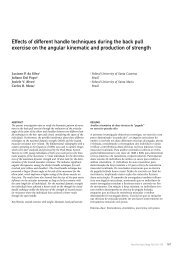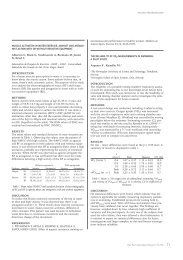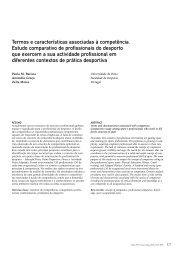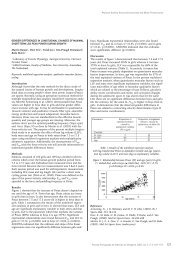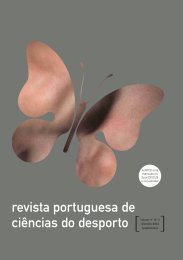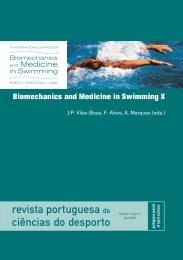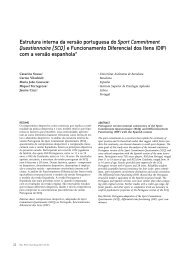adapted swimming sports and rehabilitation
adapted swimming sports and rehabilitation
adapted swimming sports and rehabilitation
Create successful ePaper yourself
Turn your PDF publications into a flip-book with our unique Google optimized e-Paper software.
Table 1. The Duration of Expending One Unit (80kcal) during<br />
Treadmill Walking in Water.<br />
velocity (km/h) young subjects (min) Olderly subjects (min)<br />
1 41.66±4.56 (41’39’’) 39.73±6.54 (39’44’’)<br />
2 33.37±4.59 (33’22’’) 31.94±4.49 (31’56’’)<br />
3 24.86±5.23 (24’51’’) 24.93±4.18 (24’56’’)<br />
DISCUSSION<br />
It was made clear that older people’s HR on l<strong>and</strong> at rest was<br />
higher, the rate of decease in HR in water at rest was lower <strong>and</strong><br />
the rate of increase in HR while exercising was higher than the<br />
young’s. From this, it was suggested that older people’s Venous<br />
Return could prevent promotion by comparison with the young.<br />
The aerobic ability of older people has decreased by comparison<br />
with the young. As a result, we thought that older people’s<br />
absolute VO 2 became the same as the young’s. So we could<br />
have to consider the duration of exercise for the patient whose<br />
body weight deviates from these subjects. For example, if<br />
patient’s weight is too high when compared with the young<br />
subjects’ we should change the duration by decreasing it.<br />
When introducing exercise we should start at lower durations,<br />
too. The Ministry of Health, Labour <strong>and</strong> Welfare in Japan<br />
advises that diabetes patients should exercise enough to sweat<br />
a little while having a conversation with their neighbor easily<br />
for about 30 minutes per day. So we could say that our index is<br />
fit for these patients.<br />
As said in the introduction it is clear that exercise on l<strong>and</strong><br />
reduces the renal blood flow rate but that in water it is maintained.<br />
By exercising on l<strong>and</strong> or in water our muscles can use<br />
glucose easily <strong>and</strong> glucose metabolism is improved; so they<br />
should exercise. Including diabetes patients that may develop<br />
diabetic renal disease, we could say that for diabetes patients<br />
exercise in water is the best choice of training for preventing<br />
deterioration of diabetes.<br />
Almost all Japanese people live on rice. The energy of a half<br />
cup of rice is about 80 kcal. So, in the diet of diabetics in<br />
Japan, the unit conversion which designates 80 kcal as one unit<br />
has been used. It suggests that the index calculated in this<br />
study is useful for the patients exercising by themselves, too.<br />
We calculated the duration of water level that is at Processus<br />
xiphoideus, too. The results were 62’41’’ (1km/h), 50’33’’<br />
(2km/h) <strong>and</strong> 37’51’’ (3km/h). If the water level goes up to the<br />
Processus xiphoideus, the duration for expending one unit<br />
becomes long. It is showed that the strength of the exercise is<br />
lower than at Trochanter major. So introducing exercise for the<br />
patients we should start at the Processus xiphoideus level.<br />
CONCLUSION<br />
In this study we calculated the duration of expending one unit<br />
(80kcal) of energy during treadmill walking in water to obtain<br />
the st<strong>and</strong>ard data to improve diabetes. Older people’s one unit<br />
data was equal to the young’s. We could expect to prevent the<br />
health of those with aggravation of diabetes or improve it using<br />
the one unit index. Using this index, we can connect it to the<br />
QOL maintenance or the improvement of life for patients with<br />
diabetes patients who also are at an advanced age.<br />
ACKNOWLEDGEMENTS<br />
For his assistance with the study the authors would like to<br />
thank Michael J. Kremenik, an associate professor at the<br />
Kawasaki University of Medical Welfare, Kurashiki.<br />
ADAPTED SWIMMING SPORTS AND REHABILITATION<br />
REFERENCES<br />
1. Ono K, Ito M, Kawaoka T, Kawano H, Shiba D, Seno N,<br />
Terawaki F, Nakajima M, Nishimura K, Onodera S (2005).<br />
Changes in heart rate, rectal temperature <strong>and</strong> oxygen uptake<br />
during treadmill walking in water <strong>and</strong> walking in a pool.<br />
Journal of Kawasaki Medical Welfare Society 14: 323-330.<br />
2. Hung CT (1989). Food exchange list based on 80-kilocalorie<br />
rice unit. Taiwan yi xue hui za zhi. Journal of the Formosan<br />
Medical Association, 88: 595-600.<br />
3. Ministry of Health, Labour <strong>and</strong> Welfare (2005). Dietary<br />
Reference Intakes for Japanese. Tokyo. Japan: Dai-ichi Syuppan<br />
Publishing Co. LTD.<br />
MOVEMENT ANALYSIS IN CAD-PATIENTS<br />
Lutz Schega1,2 , Daniel Daly2 1Otto-von-Guericke-University Magdeburg, Institute of Sport Science,<br />
Germany<br />
2K.U. Leuven, Department of Rehabilitation Sciences, Belgium.<br />
Changes in movement parameters under various load conditions<br />
during breaststroke <strong>swimming</strong> were assessed in Coronary<br />
Artery Disease (CAD) patients. Kinematic analysis of time-discrete<br />
<strong>and</strong> time-continuous characteristics, <strong>and</strong> timing of the<br />
swim-movement was made during a breaststroke “load-steptest”<br />
in a flume for 26 male CAD-patients. Factor analysis was<br />
applied. The path of h<strong>and</strong>s, feet <strong>and</strong> hips, the pause between<br />
propulsive phases <strong>and</strong> the angle of attack of hip-shoulder-water<br />
surface are of crucial importance in patients with CAD. These<br />
findings are supported by the factor analysis where comparable<br />
parameters were found to be of relevance. Results did indicate<br />
large individual variations in time-continues characteristics.<br />
Key Words: <strong>swimming</strong>, <strong>rehabilitation</strong>, biomechanics, coronary<br />
artery disease.<br />
INTRODUCTION<br />
The importance of physical activity in patients with Coronary<br />
Artery Disease (CAD) is undisputable. The aim of sport related<br />
<strong>rehabilitation</strong> is to develop an optimal specific program depending<br />
on the current condition of the individual. Nevertheless<br />
such programs focus primarily on physiological adaptations<br />
although it is well known that changes in the movement may<br />
influence this. The physiological adaptation to immersion in<br />
various water temperatures <strong>and</strong> the duration of immersion have<br />
often been investigated in this population (e.g. 1,2). Few scientific<br />
reports (5, 8), however, provide information on the actual<br />
<strong>swimming</strong> movement in patients with cardiac disease. Some<br />
studies have provided indications of the influence of movement<br />
changes on physiological responses from a qualitatively point of<br />
view, for example by Bücking et al. (2) <strong>and</strong> Meyer & Bücking<br />
(9). No quantitatively analysis has been reported however. The<br />
goal of this study, therefore, was to assess the changes in movement<br />
parameters of CAD patients under different load conditions<br />
during breaststroke <strong>swimming</strong>.<br />
METHODS<br />
Two-dimensional movement analysis (SIMI-Motion) was made<br />
during a flume “load-step-test” in breaststroke of 26 male<br />
CAD-patients: age, 59yrs. (± 8.2), infarct age, 8yrs. (± 6.8),<br />
Rev Port Cien Desp 6(Supl.2) 351-357 355



